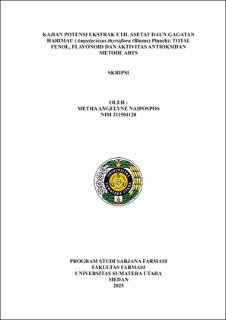| dc.contributor.advisor | Wahyuni, Henny Sri | |
| dc.contributor.author | Naipospos, Metha Angelyne | |
| dc.date.accessioned | 2025-07-24T03:18:53Z | |
| dc.date.available | 2025-07-24T03:18:53Z | |
| dc.date.issued | 2025 | |
| dc.identifier.uri | https://repositori.usu.ac.id/handle/123456789/106759 | |
| dc.description.abstract | Background: Indonesia has a huge potential biodiversity of medicinal plants, but only a small part has been scientifically studied. One plant that is still rarely studied is the Gagatan Harimau (Ampelocissus thyrsiflora), which is empirically used by the Karo people as a traditional medicine. This plant is known to contain phenolic and flavonoid compounds that act as natural antioxidants. Assays of antioxidant activity and active compound content need to be conducted to support its utilization as a natural therapeutic agent.
Objective: This study aims to determine the total phenol and flavonoid content and antioxidant activity of ethyl acetate extract of Gagatan Harimau leaves by ABTS Method.
Methods: The ethyl acetate extract was prepared by defatting using n-hexane, followed by maceration, and then analyzed for phenol content using the folin-ciocalteu method and flavonoids using the aluminum chloride method. Antioxidant activity test was conducted using the ABTS method, and the results were represented by IC₅₀ values. Quantitative analysis was performed with the help of UV-Vis spectrophotometer and IBM SPSS software version 26.
Results: Characterization of simplisia and extracts showed that the leaves of Gagatan Harimau met the quality requirements. Phytochemical screening results showed the presence of phenol compounds, flavonoids, tannins, saponins, and terpenoids. The total phenol content in the ethyl acetate extract of Gagatan Harimau leaves was 92.89 ± 1.28 mg GAE/g extract, while the total flavonoid content was 95.12 ± 1.97 mg QE/g extract. The IC₅₀ value of the ABTS method antioxidant activity test was 46.03 ± 0.09 µg/mL, which is classified as very strong antioxidant activity. Data analysis indicated a significant correlation between total flavonoid content and antioxidant activity, while phenolic content showed no significant relationship, indicating the dominant role of flavonoids and the possible involvement of other bioactive compounds.
Conclusion: The ethyl acetate extract of Gagatan Harimau leaves contained high amounts of flavonoids and phenols and showed very strong antioxidant activity. Flavonoids contributed significantly to the activity, indicating their role as dominant compounds, although other bioactive compounds may also play a role. These results support the potential of the extract as a source of natural antioxidants with promise in the development of phytopharmaceutical preparations. | en_US |
| dc.language.iso | id | en_US |
| dc.publisher | Universitas Sumatera Utara | en_US |
| dc.subject | Ampelocissus thyrsiflora (Blume) Planch | en_US |
| dc.subject | ethyl acetate | en_US |
| dc.subject | antioxidant | en_US |
| dc.subject | ABTS | en_US |
| dc.subject | Phenols | en_US |
| dc.subject | Flavonoid | en_US |
| dc.title | Kajian Potensi Ekstrak Etil Asetat Daun Gagatan Harimau (Ampelocissus thyrsiflora (Blume) Planch ) : Total Fenol, Flavonoid, dan Aktivitas Antioksidan Metode ABTS | en_US |
| dc.title.alternative | Study of the Potential of Ethyl Acetate Extract of Gagatan Harimau Leaves (Ampelocissus thyrsiflora (Blume) Planch): Total Phenols, Flavonoids and Antioxidant Activity ABTS Method | en_US |
| dc.type | Thesis | en_US |
| dc.identifier.nim | NIM211501128 | |
| dc.identifier.nidn | NIDN0122098503 | |
| dc.identifier.kodeprodi | KODEPRODI48201#Farmasi | |
| dc.description.pages | 132 Pages | en_US |
| dc.description.type | Skripsi Sarjana | en_US |
| dc.subject.sdgs | SDGs 3. Good Health And Well Being | en_US |


